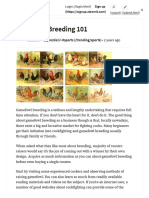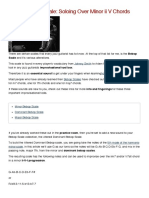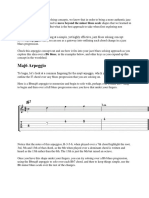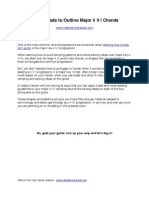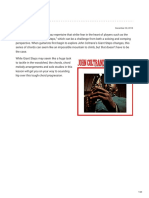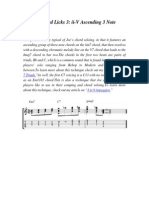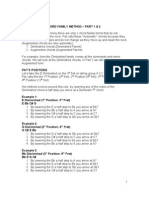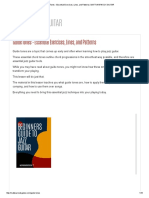83%(6)83% found this document useful (6 votes)
849 views3 To 9 Arpeggios
3 To 9 Arpeggios
Uploaded by
Johnny DemaThe document discusses how to play 3 to 9 arpeggios for jazz guitar. It explains the concept of playing arpeggios starting on the 3rd of each chord instead of the root, leaving out the root. It provides examples of 3 to 9 arpeggios over common jazz chord progressions and ways to practice and incorporate them into improvisation, such as ascending the arpeggio and descending related bebop scales.
Copyright:
© All Rights Reserved
Available Formats
Download as PDF, TXT or read online from Scribd
3 To 9 Arpeggios
3 To 9 Arpeggios
Uploaded by
Johnny Dema83%(6)83% found this document useful (6 votes)
849 views19 pagesThe document discusses how to play 3 to 9 arpeggios for jazz guitar. It explains the concept of playing arpeggios starting on the 3rd of each chord instead of the root, leaving out the root. It provides examples of 3 to 9 arpeggios over common jazz chord progressions and ways to practice and incorporate them into improvisation, such as ascending the arpeggio and descending related bebop scales.
Original Description:
very interesting
Original Title
3 to 9 Arpeggios
Copyright
© © All Rights Reserved
Available Formats
PDF, TXT or read online from Scribd
Share this document
Did you find this document useful?
Is this content inappropriate?
The document discusses how to play 3 to 9 arpeggios for jazz guitar. It explains the concept of playing arpeggios starting on the 3rd of each chord instead of the root, leaving out the root. It provides examples of 3 to 9 arpeggios over common jazz chord progressions and ways to practice and incorporate them into improvisation, such as ascending the arpeggio and descending related bebop scales.
Copyright:
© All Rights Reserved
Available Formats
Download as PDF, TXT or read online from Scribd
Download as pdf or txt
83%(6)83% found this document useful (6 votes)
849 views19 pages3 To 9 Arpeggios
3 To 9 Arpeggios
Uploaded by
Johnny DemaThe document discusses how to play 3 to 9 arpeggios for jazz guitar. It explains the concept of playing arpeggios starting on the 3rd of each chord instead of the root, leaving out the root. It provides examples of 3 to 9 arpeggios over common jazz chord progressions and ways to practice and incorporate them into improvisation, such as ascending the arpeggio and descending related bebop scales.
Copyright:
© All Rights Reserved
Available Formats
Download as PDF, TXT or read online from Scribd
Download as pdf or txt
You are on page 1of 19
At a glance
Powered by AI
The document discusses playing 3 to 9 arpeggios for jazz guitar by leaving out the root note and starting on the third of each chord.
3 to 9 arpeggios involve playing the arpeggio from the third to the ninth of each chord, leaving out the root note. This adds color and avoids always starting on the root.
Common 3 to 9 arpeggio formulas in minor keys include m7b5 3 to 9 arp= dim7 starting on the 3rd of the chord and minMaj7 3 to 9 arp= Maj7(#5) starting on the 3rd of the chord.
pdfcrowd.com open in browser PRO version Are you a developer?
Try out the HTML to PDF API
How to Play 3 to 9 Arpeggios for Jazz Guitar
Many of us that are learning how to play bebop jazz guitar have practiced arpeggios and
use them in our soloing over jazz tunes, especially Bebop tunes where the chords often
move at a breakneck pace and we need to navigate them very quickly.
But what do we do when we become bored with the regular, ole root-3-5-7 arpeggios
that we have under our fingers?
There are many directions we can go at this point, when we have the standard
arpeggios down and need to expand our playing further, and one of the best and most
common approaches that we can check out is the 3 to 9 arpeggio concept.
The concept itself is fairly simple, we just play the arpeggio for each chord that we are
soloing over using the intervals, 3, 5, 7 and 9, leaving out the root.
Why would we do this you may ask? Well, one reason is that adding the 9th gives us an
extra color tone in our playing, one that is more jazzy and colorful than the root.
Secondly, as guitarists, we have a habit of starting our lines, at least early on when we
MATT WARNOCK GUITAR
Your Online Guide to Playing Better Jazz Guitar
Home Beginner Improver Resources Skype Lessons Forum All articles Login Search
pdfcrowd.com open in browser PRO version Are you a developer? Try out the HTML to PDF API
are first learning jazz, on the lowest note of any shape or fingering weve learned,
mostly because its the first note we see on the neck in that position and weve practiced
running up and down arpeggios starting on the root in our practice rooms.
But, if we simply take the root out, and start these ideas on the 3rd of each chord, we
are getting rid of that boring sounding root and even if we start every line on the lowest
note in our arpeggio shapes, it will now be the 3rd, a more interesting note that the root.
The first thing that we will take a look at is the arpeggios for a ii-V-I in Cmaj7, starting
from the root of each chord and running up to the ninth. These are by no means the
only fingerings for these arpeggios, but they work well for the context of this lesson.
If you want to learn more about these fingerings, check out the Guitar Arpeggio page on
my site, which contains many one and two octave fingerings for these, and other,
arpeggios.
Root to 9th Arpeggios
pdfcrowd.com open in browser PRO version Are you a developer? Try out the HTML to PDF API
With the root to 9 arpeggio under our fingers, lets go ahead and remove the root from
the equation, leaving us with an arpeggio that starts on the 3rd of each chord and
finishes on the 9th. When we do this, an interesting thing happens, we are left with a new
arpeggio for each chord.
Dm7 is now Fmaj7 (FACE), G7 is now Bm7b5 (BDFA) and Cmaj7 is now Em7 (EGBD).
Not only is this a cool theory tidbit to get into our palette, but it will help us learn and
memorize the 3 to 9 arpeggios. Instead of thinking of the intervals of each chord, just
think of these relationships:
m7 3 to 9 arp= Maj7 starting on the 3rd of the chord
7 3 to 9 arp= m7b5 starting on the 3rd of the chord
Maj7 3 to 9 arp= m7 starting on the 3rd of the chord
Since we are only looking at major key 2-5-1s in this lesson, here are a couple of other
popular 3 to 9 formulas in the minor keys that you can apply to your playing.
m7b5 3 to 9 arp= m7 starting on the 3rd of the chord
7(b9) 3 to 9 arp= dim7 starting on the 3rd of the chord
minMaj7 3 to 9 arp= Maj7(#5) starting on the 3rd of the chord
pdfcrowd.com open in browser PRO version Are you a developer? Try out the HTML to PDF API
With our heads wrapped around the 3 to 9 concept, and how we can apply arpeggios
that we already know to the 3rd of these chords to build them, lets get them under our
fingers in a ii-V-I in C Major.
Again, this is only one position for these arpeggios, there are many more to explore,
so be sure to try and learn as many ways to please these arpeggios across the neck as
possible.
If you are looking for ways to spice up these arpeggios, so you dont just play them up
and down when soloing, check out my lesson on Adding Chromatics to Basic
Arpeggios for ways to add more interest to your arpeggio lines.
3 to 9 Arpeggios
While playing these arpeggios is a great way to outline chords and chord changes,
without having to play the root all the time, only playing these arpeggios can become
pdfcrowd.com open in browser PRO version Are you a developer? Try out the HTML to PDF API
boring after a while, though it is a great exercise to learn the 3 to 9 arpeggio for all
of the chords in a tune youre learning and only solo with these arpeggios.
So, how do we spice up this concept to make it more musical and get it to sound more
jazzy?
One of the easiest ways, and a way that jazz players have been using going all the way
back to Charlie Parker and the Bebopers, is to play the 3 to 9 arpeggio ascending,
from 3rd to the 9th, and then descend the Bebop scale that fits the chord you are on.
So for m7 it would be the Minor Bebop Scale, for 7th chords it would be the Dominant
Bebop Scale and for Maj7 chords it would be the Major Bebop Scale.
If you are unfamiliar with these scales, check out my page on Bebop Scales for
Guitar as well as 21 Bebop Scale Patterns for Guitar to learn more about this often used,
and very cool, scale device.
In the example below, we have the 3 to 9 arpeggio ascending for each chord in the ii-V-I,
followed by its related descending Bebop scale. At first, just practice this concept as is,
up the arpeggio and down the scale, in a given position. But, once you have the
fingerings memorized, start to improvise with this idea right away.
Change the rhythms, add notes, use some of the Bebop Scale Patterns you know etc.
Then move on to a different position on the neck and learn the fingerings there for each
arpeggio and scale, and improvise in that position right away.
Its very important to practice improvising with these, or any, jazz concept because as
the great jazz guitarist Roddy Ellias once told me, nobody has ever paid me to play
scales, they pay me to play music!
pdfcrowd.com open in browser PRO version Are you a developer? Try out the HTML to PDF API
3 to 9 Arpeggios Exercise 1
With the 3 to 9 arpeggios, and their related Bebop Scales, under our fingers and in our
ears, we can now apply this concept to any tune or chord progression that were working
on. A good rule of thumb is to do the following exercises over a tune to help internalize
this concept in the context of that particular song:
Play the 3 to 9 arpeggios all ascending for each chord
pdfcrowd.com open in browser PRO version Are you a developer? Try out the HTML to PDF API
Play the 3 to 9 arpeggios all descending for each chord
Play the 3 to 9 arpeggios ascending for the first chord, then descending for the
next etc.
Play the 3 to 9 arpeggios descending for the first chord, then ascending for the
next etc.
Play the 3 to 9 arpeggio and related Bebop Scale for each chord
Improvise using only the 3 to 9 arpeggio for each chord
Improvise using the 3 to 9 and related Bebop Scale for each chord
Below are a few different licks that I came up with to demonstrate 3 to 9 arpeggios
and their related Bebop Scales in the context of a Major ii-V-I progression.
Check out these licks, then come up with some of your own, for this and other chord
progressions that youre working on. As well, when youre transcribing solos from
famous players, try and pick out the different instances to see how your favorite
guitarists use this concept.
Youll find that cats such as Pat Martino, Mike Stern and Kenny Burrell all use 3 to 9
arpeggios, but in slightly different ways, which might push you in different directions
with your own playing.
3 to 9 Arpeggios Lick 1
pdfcrowd.com open in browser PRO version Are you a developer? Try out the HTML to PDF API
Click to
VmP
.
3 to 9 Arpeggios Lick 2
Click to
VmP
.
pdfcrowd.com open in browser PRO version Are you a developer? Try out the HTML to PDF API
Login to rate and bookmark posts
Share
3 to 9 Arpeggios Lick 3
Click to
VmP
.
Do you have a favorite way to practice or apply 3 to 9 arpeggios to your playing?
Share it in the 3 to 9 Arpeggio thread in the MWG Forum.
pdfcrowd.com open in browser PRO version Are you a developer? Try out the HTML to PDF API
Tweet
3
1
33 Comments
1. Mike, June 26, 2011:
Brother this is incredible.
2. Matt Warnock, June 26, 2011:
Thanks Mike, glad you dug it!
3. Mike, June 27, 2011:
Yea, no problem man, glad youre posting this stuff for free. This has been more
informative than the Berklee book. Ive been looking for a way to negotiate Donna
Lees changes and this is it. I especially like the patterns woven with the bebop
scales and arpeggios, it reminds me alot of Parkers and Tal Farlows approach.
4. Matt Warnock, June 27, 2011:
yeah, I think thats the key, mixing in the Bebop patterns etc, that really gives it
that Martino Mike Stern kind of vibe, glad youre diggin it!
5. Mike, June 28, 2011:
Oh, yea definately, I hear alot of Martinos style come out with this type method.
What is also interesting, is that most of of the melodic devices you covered in
Three Elements of Music happen on their own if you use weave arpeggios and
scales together.
134
Like
pdfcrowd.com open in browser PRO version Are you a developer? Try out the HTML to PDF API
6. Matt Warnock, June 28, 2011:
For sure, since we are all strapped for time I try and practice all three elements
together whenever I can, keeps me moving forward with all three and doesnt eat
up all my time with just one or the other.
7. rick bourne, July 16, 2011:
great concept,Iwish I could add more the lesson says it
8. Matt Warnock, July 16, 2011:
thanks Rick, appreciate you checking out the article!
9. adam, July 25, 2011:
this is a fantastic lesson matt, ive been solely working on 3 to 9 arps for about a
week now and its done wonders to my playing already. really expanded my ear as
well. ive also been listening to a lot of Horace Silver lately; he seemingly builds
entire solos out of just these 3 t0 9 arps!!
10. Matt Warnock, July 25, 2011:
Hey Adam,
Thanks for checking out the lesson! Yeah 3 to 9 arpeggios are fantastic ways to
outline chords and tons of famous guys use them, like you said some almost
exclusively. Mike Stern and Pat Martino come to mind as guitarists who love this
technique.
If you havent already, check out the 3 to 7 triad article, great way to expand these
ideas further, guys like Wynton Kelly made a career out of playing these ideas.
http://mattwarnockguitar.com/jazz-guitar-chords-3-to-7-triads
11. Mike, July 29, 2011:
Hey Matt, Ive been using this system for the last month, and Ive got alot of gain
pdfcrowd.com open in browser PRO version Are you a developer? Try out the HTML to PDF API
out of it. However, I found I was getting as much color as I wanted out of the
arrpeggios, especially when two minor chords were next to each other in a
progression. Take a g-7 chord(Gminor7). a 3,5,7,9 would be Bb, D, F, A. So
instead I started using a 3,5,7,9 on a Bbmaj7 Chord, D, F, A, C, and I noticed I
was getting a significant amount of more color! I wish I could say this idea was
mine, but Ive read that Wes loved subbing relative major/minor arrpegios in his
soloing.
12. Mike, July 29, 2011:
Sorry, *I was *not* getting as much color as I wanted
13. Matt Warnock, July 29, 2011:
Yeah, the 3 to 9 is the first step to get away from root-7 arpeggios. Mike Stern
really likes 5-11 arpeggios, so Dm7 over G7, the sound youre talking about
basically.
Sheryl Bailey talks about the family of four thats where you harmonize every
note over a dominant 7th chord and use those arpeggios.
So for G7 try using G7-Bm7b5-Dm7-Fmaj7
or for Gm7 try using Gm7-Bbmaj7-Dm7-Fmaj7
very cool sounds in there, mix it up with some Bebop patterns and youre cookin!
14. Mike, July 29, 2011:
Brother, you are Treasure chest of KnowledgeThanks for the gifts!
15. Matt Warnock, July 29, 2011:
No problem man, glad I could help out, hope you keep diggin the site.
16. ankkiz, August 6, 2011:
pdfcrowd.com open in browser PRO version Are you a developer? Try out the HTML to PDF API
Hi
on the Cmaj7 (Em7) you used Phrygian Bebop scale (Phryg + M3) but didnt
mention anything about it.
It might be confusin for some student who is unfamiliar with bepopscales.
17. Matt Warnock, August 6, 2011:
Hey Ankkiz,
I used the major Bebop scale on that chord, which I mentioned in the text
So for m7 it would be the Minor Bebop Scale, for 7th chords it would be the
Dominant Bebop Scale and for Maj7 chords it would be the Major Bebop Scale.
with links to articles with the fingerings and definition of the scales there.
For me, the Ab or G#, is the b6 of the C Major Bebop Scale, not a Phrygian mode
sound. Though Im thinking Em7 for the 3 to 9 arpeggios, the scale is a C Major
Bebop so its related to the tonic sound of the chord.
Thats all, nothing fancy, just the 3 to 9 ascending (Em7) and the Major Bebop
Scale (C Major) descending.
18. John, August 11, 2011:
Great stuff! Ive been doing this for some time now and its great to see someone
explaining it!Great job. I try to think of each triad built from the R,3rd,5th,7th of
a given chord and then relate that to its chord function.
19. Matt Warnock, August 11, 2011:
For sure John, great ways to take concepts you know, triads and arpeggios, and
use them in a new way to create a whole new sound in your playing.
Getting a lot of bang for your buck with these ideas for sure!
pdfcrowd.com open in browser PRO version Are you a developer? Try out the HTML to PDF API
20. yusuf, August 15, 2011:
This I was looking for
21. Matt Warnock, August 15, 2011:
thanks Yusuf, glad you dug the article!
22. Mark, September 10, 2011:
Thank you very much for this great article and all the other cool stuff on your site!
These 3 to 9 arpeggios really add a great deal of melodic interest. Especially
when you start applying them to the melodic minor scale (Dm7 vamp is what im
working on at the moment), got too love that Fmaj7#5 sound
23. Matt Warnock, September 10, 2011:
For sure Mark, love that sound of Fmaj7#5 over Dm7.
24. AJ Green, December 17, 2011:
Oh crap, I just found this lesson. its 11:30 at night and I just put on a pot of coffee
and grabbed my guitar. coolest thing Ive learned in a while, thanks for going to all
this trouble for us Matt. Ill be working on this all night.
25. Matt Warnock, December 17, 2011:
Hey AJ,
Glad you dug the lesson, but sorry I ruined your getting a good nights sleep!
26. AJ Green, December 17, 2011:
No prob, all I got is time. Now, after checking out more of your site I can really say
thanks. The insights you teach may be basic jazz concepts but you have a real
talent for presenting them in a clear and orderly way.
You keep posting and Ill keep practicing.
pdfcrowd.com open in browser PRO version Are you a developer? Try out the HTML to PDF API
27. Matt Warnock, December 17, 2011:
Thanks AJ, Ill keep posting! Have you signed up for my free newsletter yet? If not
you can do so in the top right of the sidebar on any page on my site. You get two
free ebooks for signing up and a free, newsletter exclusive lesson each Monday.
So check it out if you havent already.
28. AJ Green, December 17, 2011:
Yep, all signed up. Thanks for all your dedication.
29. Kurt Rehbein, December 9, 2012:
Thanks very much Matt,
Great lesson. Just what I have been looking for.
30. Matthew Warnock, December 9, 2012:
No problem glad you dug the article!
31. adam smith, January 5, 2013:
hi matt love it could you briefly explain
7(b9) 3 to 9 arp= dim7 starting on the 3rd of the chord
minMaj7 3 to 9 arp= Maj7(#5) starting on the 3rd of the chord
thanks Matt
32. Matthew Warnock, January 6, 2013:
yep those are correct. For G7b9 you could play B D F Ab, Bdim7, for GmMa7 you
could play Bbmaj7#5, Bb D F# A.
33. adam smith, January 6, 2013:
got it thanks
pdfcrowd.com open in browser PRO version Are you a developer? Try out the HTML to PDF API
Add comments about this page
Name (required)
E-mail (will not be published) (required)
Submit
Notify me of followup comments via e-mail. You can also subscribe without
commenting.
JAZZ GUITAR - BEGINNERS
pdfcrowd.com open in browser PRO version Are you a developer? Try out the HTML to PDF API
JAZZ GUITAR - IMPROVERS
JAZZ GUITAR - RESOURCES
pdfcrowd.com open in browser PRO version Are you a developer? Try out the HTML to PDF API
FORUM LOGIN RECENT FORUM TOPICS FREE Jazz Guitar eBook!
Related Articles
How To Play Jazz Guitar Arpeggios
How To Play MMaj7th Arpeggios For Jazz Guitar
How To Play Dim7 Arpeggios For Jazz Guitar
How To Play Dominant 7th Arpeggios For Jazz
Guitar
How To Play Minor 7th Arpeggios For Jazz Guitar
pdfcrowd.com open in browser PRO version Are you a developer? Try out the HTML to PDF API
Not a member yet?
Click here to sign up
Username
Password
GO
Learning the 7 Modes
Video, Trio with Nylon strung
Painting With Music
Benefits of Learning an
Instrument on the Brain
Django Documentary
Building Scales off the 6th
Degree -
Guess the Arpeggio
Answers
Sign up for my FREE email guitar
lessons and get a copy of:
"Beginner's Guide to Jazz Guitar"
Your Email
First Name
Subscribe
You might also like
- Volume 5 - George Benson - ModalDocument44 pagesVolume 5 - George Benson - Modalrafaurre80% (5)
- Guide Tones - 10 Essential Soloing Patterns - MATT WARNOCK GUITARDocument9 pagesGuide Tones - 10 Essential Soloing Patterns - MATT WARNOCK GUITARPedroMiranda100% (1)
- Grant Green II V I - Lick Analysis, ConceptsDocument17 pagesGrant Green II V I - Lick Analysis, Conceptsrla9762388% (8)
- Sample SoloDocument4 pagesSample SoloMatteo Galli100% (3)
- Approach Notes and EnclosureDocument39 pagesApproach Notes and EnclosureAlfa Kim00780% (5)
- Gamefowl Breeding 101 - Steemit PDFDocument10 pagesGamefowl Breeding 101 - Steemit PDFGregorio Austria0% (1)
- Bebop ArpeggiosDocument16 pagesBebop ArpeggiosJohnny Dema67% (15)
- 5 Must Know Bebop Phrases For GuitarDocument6 pages5 Must Know Bebop Phrases For GuitarJose Maria Hidalgo100% (1)
- Altered Ect LicksDocument3 pagesAltered Ect LicksMichael Andritsopoulos100% (1)
- 5 Approaches To Soloing Over The Bridge To Rythm ChangesDocument11 pages5 Approaches To Soloing Over The Bridge To Rythm Changesvetah.ndaw1974100% (3)
- Vol 3 - Barney Kessel - BebopDocument32 pagesVol 3 - Barney Kessel - BebopBryan Windson100% (1)
- Minor Bebop ScaleDocument10 pagesMinor Bebop ScalePedroMirandaNo ratings yet
- Altered Bebop Scale - Soloing Over Minor II V ChordsDocument5 pagesAltered Bebop Scale - Soloing Over Minor II V ChordsPedroMiranda100% (2)
- Jazz Improvisation - Essential Exercises, Technique, and Tips - MATT WARNOCK GUITARDocument42 pagesJazz Improvisation - Essential Exercises, Technique, and Tips - MATT WARNOCK GUITARleofds100% (1)
- Jazz BebopDocument48 pagesJazz Beboplarry48100% (4)
- Jazz Blues Soloing Concept - Min vs. MajDocument5 pagesJazz Blues Soloing Concept - Min vs. MajdesireormanNo ratings yet
- The Master Arpeggio System for Jazz Improvisation II: Minor & More for Electric GuitarFrom EverandThe Master Arpeggio System for Jazz Improvisation II: Minor & More for Electric GuitarNo ratings yet
- Three Quick Jazz Practice Tips: for all instruments: Jazz & Improvisation Series, #3From EverandThree Quick Jazz Practice Tips: for all instruments: Jazz & Improvisation Series, #3Rating: 5 out of 5 stars5/5 (1)
- Melodic Minor ScaleDocument17 pagesMelodic Minor ScaleAlfa Kim007No ratings yet
- How To Play The Augmented Scale On Guitar - MATT WARNOCK GUITARDocument9 pagesHow To Play The Augmented Scale On Guitar - MATT WARNOCK GUITARPedroMiranda100% (1)
- Major II V I Triads Matt Warnock GuitarDocument9 pagesMajor II V I Triads Matt Warnock GuitarSrđan Sarkanjac100% (1)
- Wes' V-I Chord Concept: Jazz Guitar Legend Wes MontgomeryDocument6 pagesWes' V-I Chord Concept: Jazz Guitar Legend Wes Montgomerythaneyoung100No ratings yet
- Comping With Bass LinesDocument4 pagesComping With Bass Linesprimus2No ratings yet
- CompingDocument16 pagesCompingFrancis Amora67% (3)
- How To Use Arpeggios in Jazz Important SkillsDocument3 pagesHow To Use Arpeggios in Jazz Important SkillsJ AraujoNo ratings yet
- 5 Extended Jazz Guitar Arpeggio ExercisesDocument3 pages5 Extended Jazz Guitar Arpeggio ExercisesPedroMiranda50% (2)
- Jazzguitar - Be Giant StepsDocument23 pagesJazzguitar - Be Giant StepsRudy Kolder100% (1)
- Turnarounds: How To Turn One Chord Into Four: Home Jazz Guitar Store The Blog Guitar Forum Free BookDocument7 pagesTurnarounds: How To Turn One Chord Into Four: Home Jazz Guitar Store The Blog Guitar Forum Free Bookcabralbruno10100% (1)
- Joe Pass Chord Licks 3Document1 pageJoe Pass Chord Licks 3William LettauNo ratings yet
- Quartal Harmony For Jazz Guitar PDFDocument2 pagesQuartal Harmony For Jazz Guitar PDFMarcelo Pirôpo100% (2)
- Martino Chord FamilyDocument9 pagesMartino Chord FamilySrđan Sarkanjac100% (1)
- Blue Bossa Harmonic Analysis: Learning How To Play Jazz GuitarDocument11 pagesBlue Bossa Harmonic Analysis: Learning How To Play Jazz Guitarjlouis2000No ratings yet
- Vol 2 - Wes Montgomery - II-V-IDocument44 pagesVol 2 - Wes Montgomery - II-V-IBryan WindsonNo ratings yet
- Joe Pass JAZZ LINESDocument10 pagesJoe Pass JAZZ LINESMich Lobo FloresNo ratings yet
- Approach NotesDocument3 pagesApproach NotesnotbuggedNo ratings yet
- Barney Kessel WisdomDocument8 pagesBarney Kessel WisdomPoss Hum100% (2)
- Intermediate Guide To Jazz Improvisation - MATT WARNOCK GUITARDocument37 pagesIntermediate Guide To Jazz Improvisation - MATT WARNOCK GUITARDenis MarinangeliNo ratings yet
- Jazz Rhythms For Guitar Comping and Soloing StudiesDocument26 pagesJazz Rhythms For Guitar Comping and Soloing Studiesgelu1999100% (2)
- 1 Joe PassDocument7 pages1 Joe PassNattapong keawsaichooNo ratings yet
- Altered Scale Essential Patterns Licks and FormulaDocument11 pagesAltered Scale Essential Patterns Licks and FormulaJknoxvil75% (4)
- The Dominant Diminished Scale For GuitarDocument8 pagesThe Dominant Diminished Scale For Guitarrla97623100% (2)
- Altered DominantsDocument5 pagesAltered Dominantspnogrl100% (4)
- Volume 4 - Pat Martino - MinorDocument45 pagesVolume 4 - Pat Martino - Minorrafaurre92% (13)
- Tritone ScaleDocument15 pagesTritone ScaleAlfa Kim007100% (1)
- Whole Tone Scale Examples Chords and TabDocument17 pagesWhole Tone Scale Examples Chords and TabDaniel UrdayNo ratings yet
- Ariel Kasler GIANT STEPS CHORD SUBSTITUTIONS PDFDocument94 pagesAriel Kasler GIANT STEPS CHORD SUBSTITUTIONS PDFAnonymous 1Rb4QLr100% (7)
- Cells and 7th Arpeggios For GuitarDocument5 pagesCells and 7th Arpeggios For GuitarMilton Mermikides50% (2)
- Complete Guide To Jazz Scales and Modes - Matt WarnockDocument151 pagesComplete Guide To Jazz Scales and Modes - Matt WarnockDavid Savage100% (2)
- Variations On Ii-V-IDocument5 pagesVariations On Ii-V-Iescutelo0% (1)
- Phrygian Dominant Scale Guitar Patterns Chords and HarmonyDocument19 pagesPhrygian Dominant Scale Guitar Patterns Chords and HarmonyToroPolacoNo ratings yet
- Miles Davis Soloing Techniques For Jazz Guitar - MattWarnockGuitarDocument9 pagesMiles Davis Soloing Techniques For Jazz Guitar - MattWarnockGuitaroliveira_thales0% (1)
- Jazz Lines Lessons 1Document3 pagesJazz Lines Lessons 1Marcio PereiraNo ratings yet
- Drop 2 and 4 Chords - Creative Guitar Voicings - MATT WARNOCK GUITARDocument45 pagesDrop 2 and 4 Chords - Creative Guitar Voicings - MATT WARNOCK GUITARraf50% (2)
- Adding Some Jazz Fusion Spice To Your BluesDocument5 pagesAdding Some Jazz Fusion Spice To Your BluesdesireormanNo ratings yet
- Guide Tones - Essential Exercises, Lines, and Patterns - MATT WARNOCK GUITARDocument16 pagesGuide Tones - Essential Exercises, Lines, and Patterns - MATT WARNOCK GUITARLouis Migliore75% (4)
- Pentatonic SubsDocument4 pagesPentatonic SubsJazzGuy100% (2)
- 4 Jazz Blues Lenny Breau Chord StudiesDocument9 pages4 Jazz Blues Lenny Breau Chord Studiesmigueldelaquila554025% (4)
- Piano Touch EssayDocument17 pagesPiano Touch EssayJohnny DemaNo ratings yet
- Atdh DTHD Thadht Adt DTH Adht Adht Adt Ha DTH Adth Adht Ad Hta DTH Aht Adtha D DT Secret MatriDocument1 pageAtdh DTHD Thadht Adt DTH Adht Adht Adt Ha DTH Adth Adht Ad Hta DTH Aht Adtha D DT Secret MatriJohnny DemaNo ratings yet
- Tosin AbasiDocument2 pagesTosin AbasiJohnny Dema0% (1)
- PrimeroDocument1 pagePrimeroJohnny DemaNo ratings yet
- AaronDocument48 pagesAaronJohnny Dema43% (7)
- Aas0117 (0) - Jazz Improvisation TipsDocument29 pagesAas0117 (0) - Jazz Improvisation Tipssarplaninec67% (3)
- Tommy Emmanuel - OnlyDocument90 pagesTommy Emmanuel - OnlyJohnny Dema50% (2)
- Wagner - Wedding MarchDocument4 pagesWagner - Wedding MarchJohnny Dema100% (1)
- Class 12 Mathematics Guess (2025)Document31 pagesClass 12 Mathematics Guess (2025)r98522931No ratings yet
- GADGET-2 Best PracticesDocument3 pagesGADGET-2 Best PracticesIrvin MartinezNo ratings yet
- Step by Step Oracle Installation Guides Kamran AgayevDocument201 pagesStep by Step Oracle Installation Guides Kamran AgayevSayed NabilNo ratings yet
- Trial Exam PaperDocument15 pagesTrial Exam PaperwilsonleongNo ratings yet
- Delhi HR DatabaseDocument46 pagesDelhi HR DatabaseKushal AgrawalNo ratings yet
- 1a ViscosityDocument13 pages1a ViscosityJohn InyiamaNo ratings yet
- VERBS FOLLOWED by Infinitive or GerundDocument4 pagesVERBS FOLLOWED by Infinitive or GerundJackie RicoNo ratings yet
- G7 GeographyDocument20 pagesG7 Geographyzahra sikanderNo ratings yet
- When To Eat FlaxseedDocument3 pagesWhen To Eat FlaxseedAarya ShekhawatNo ratings yet
- Topics 1. A Study On Green Accounting, Reporting Practices & Its Impact On Sustainability ReportDocument1 pageTopics 1. A Study On Green Accounting, Reporting Practices & Its Impact On Sustainability ReportPrajwal kumarNo ratings yet
- Good Times and Hardships Answer Key: Chapter 13 Literacy Skill PracticeDocument2 pagesGood Times and Hardships Answer Key: Chapter 13 Literacy Skill PracticeAna Berta de PalomoNo ratings yet
- Simple Present Games e Worksheet D8pfi5Document19 pagesSimple Present Games e Worksheet D8pfi5My Spot English SpaceNo ratings yet
- Chapter OneDocument71 pagesChapter OneWube YihuneNo ratings yet
- English Project Work - 2081Document3 pagesEnglish Project Work - 2081Aastha SharmaNo ratings yet
- Complete Enterprise StructureDocument13 pagesComplete Enterprise StructuresivahariNo ratings yet
- Simple Field Planting Records TemplateDocument7 pagesSimple Field Planting Records TemplateDevang shrivasNo ratings yet
- Recursion & Pointers: Instructor: Alvin R. LebeckDocument6 pagesRecursion & Pointers: Instructor: Alvin R. Lebeckmerlin2007No ratings yet
- AbdomenDocument55 pagesAbdomenAngie LawrenceNo ratings yet
- CPE - Stage 5 - AcknowledgementsDocument1 pageCPE - Stage 5 - AcknowledgementshotanNo ratings yet
- Documentary Script 2018 (AIWVC) PDFDocument6 pagesDocumentary Script 2018 (AIWVC) PDFMahin RahmanNo ratings yet
- Time As SpiralDocument26 pagesTime As SpiralLucioMauricioHenaoVélezNo ratings yet
- Fiber Evidence WorksheetDocument3 pagesFiber Evidence Worksheetkymani2007.jNo ratings yet
- DLP ICT CSS Week 3Document12 pagesDLP ICT CSS Week 3Argesil SaysonNo ratings yet
- Home Renovation Project MetricsDocument7 pagesHome Renovation Project MetricsAsma AliNo ratings yet
- History of InternetDocument23 pagesHistory of InternetCornell DagotNo ratings yet
- Coke Vs Pepsi, 2001Document35 pagesCoke Vs Pepsi, 2001alaa_mehsen100% (3)
- Earth Resources and Engineering Lab CO PO Justification 21CV34 LabDocument9 pagesEarth Resources and Engineering Lab CO PO Justification 21CV34 Labarun_68No ratings yet
- Equipment Maintenance Step 1 2 3 - ACT - TRG - 053Document74 pagesEquipment Maintenance Step 1 2 3 - ACT - TRG - 053occhityaNo ratings yet
- Multi Choice Questions On Income Approach K. C. Jhavar, Btech, Mba, Mval (Re) Retd. Asst. Gen. Manager, Erst S. B. Indore Govt. Regd. ValuerDocument8 pagesMulti Choice Questions On Income Approach K. C. Jhavar, Btech, Mba, Mval (Re) Retd. Asst. Gen. Manager, Erst S. B. Indore Govt. Regd. ValuerAnirban DeyNo ratings yet







